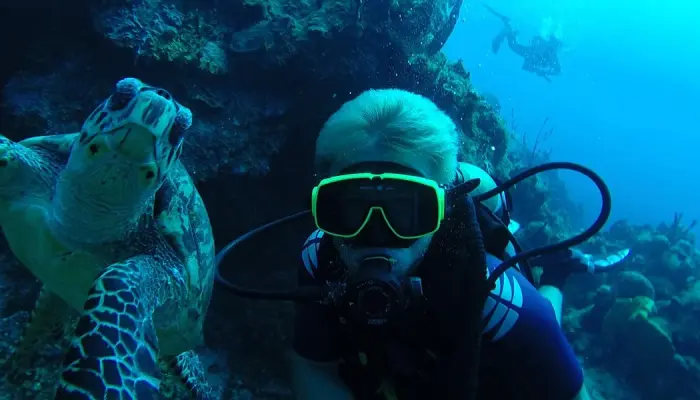This guide has been compiled by Mads Staal. Mads worked as a diving instructor in Bali and has completed hundreds of dives in local waters.
Padang Bai
Located on Bali's eastern coast is the small port town of Padang Bai. From here, you can take a ferry to Lombok or the popular Gili Islands. This area offers ideal diving and snorkeling opportunities for both beginners and experienced divers with Advanced Open Water certification and higher.
Padang Bai is famous for its white sandy dunes, dazzling coral reefs of all colors of the rainbow, and magical macro diving. The rich diversity of marine life will satisfy all tastes: from tiny charming clownfish to blue spotted stingrays and sea turtles, from reef striped sharks to whitetip sharks. Additionally, there's a fantastic opportunity to get a closer look at the amazing macro world of marine inhabitants!
Blue Lagoon
Departing from Padang Bai on a traditional boat, about 10 minutes away, you can make your first stop at Blue Lagoon. This is one of the most popular diving spots in Bali. The consistently beautiful blue water color clearly explains the origin of this place's name. It's perfect for beginners and snorkeling, as the dive begins from a sandy bottom at a depth of 5 meters. From there, you can move to the coral reefs, where the depth reaches 20 meters. However, divers often stay at a depth of 12-15 meters, as this is where the greatest variety of marine inhabitants are found.
In the Blue Lagoon, you are most likely to see clownfish, sea turtles, morays, seahorses, and numerous coral fishes.
Jepun
This site offers a multitude of fascinating experiences. Here you can observe how corals are successfully cultivated in Bali. The cultivated corals hang on supports, similar to grapevines in a vineyard. This method of coral cultivation has become revolutionary for marine biologists worldwide, who have the opportunity to replicate it in hopes of stopping the disappearance of coral reefs.
In addition to coral plantations, there is also a chance to see natural coral reefs. With luck, you might encounter the popular razorfish. This fish always moves in large schools. It got its name due to its resemblance to a razor blade. With their heads down, they constantly move up and down the sandy bottom, resembling a ballet dance.
At a depth of about 25 meters, you can find a well-preserved wreck – a small fishing boat. Here, with luck, you can meet large groups of sea cats.
In addition to many amazing fish, sometimes you can spot a submarine. It departs from Padang Bai with tourists who are hesitant to dive. Meeting a submarine while diving is always a fun adventure. Often, the diver becomes an attraction for submarine passengers. So, if you're photogenic, you have a great opportunity to show off your best poses if you're lucky enough to encounter a submarine during your dive.
Jetty
My absolute favorite place in Bali! This is a local secret, so few diving companies offer tours here.
Here you'll indeed have the chance to test your underwater cameras, as photo subjects are constantly encountered!
The dive takes place between the pillars of an old bridge. This site is a true paradise for macro diving. Here you won't see bright coral reefs like in other parts of Padang Bai. However, you are almost guaranteed to encounter such inhabitants as octopuses, mantis shrimps, sea cats, tunas, dolphins, wasp fish, the popular and extremely rare frogfish, as well as typical coral fish.
Occasionally, look up during your dive, as you might see large tunas or even dolphins hunting the numerous schools of fish under the bridge. In some cases, giant mantas have also been spotted near the bridge.
The diving depth is 16-20 meters. Cold currents are often present, so be sure to bring a 3mm wetsuit.
Additionally, the bridge under which the dive takes place is a popular fishing spot among locals. Therefore, also be cautious of fishing lines and hooks if you venture onto the sandy bottom.
Biastugal
"Biastugal" translates from Indonesian as "white beach." This name comes from the small pristine white sandy beach visible from the water.
During this dive, you'll experience an exceptional variety of corals, represented in all forms and colors!
